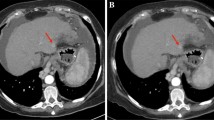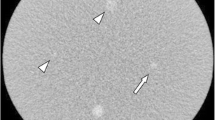Abstract
Purpose
This study sought to investigate the effect of the hybrid iterative reconstruction (IR) algorithm (iDose, Philips Healthcare) on the improvement of image quality of computed tomography (CT) scans of the liver and determine the appropriate level of IR strength for clinical use.
Materials and methods
A total of 75 patients (41 men and 34 women; mean age, 59.5 years) with a primary abdominal malignancy who underwent two-phase liver CT scans for the work-up of their liver metastases, were included in this study. The CT images during the portal phase were reconstructed using either filtered back projection (FBP) or the hybrid IR algorithm with six different levels of IR strengths. The signal-to-noise ratio of the liver (SNRliver) and the contrast-to-noise ratio of the portal vein to muscle (CNRpv to m) were measured. For qualitative analysis, image noise, visibility of small intrahepatic vascular structures, beam-hardening artefact, lesion conspicuity, and overall image quality were graded by two radiologists.
Results
Quantitative analysis demonstrated that image noise was significantly reduced along with the increasing level of iDose and that the values of SNRliver and CNRpv to m were significantly better with iDose than those of FBP images. Qualitative assessment also showed significantly better results with iDose compared with FBP (p < 0.05) and the parameters for subjective image quality were highest with iDose level 4.
Conclusions
The hybrid IR technique is able to reduce image noise and to provide better image quality than FBP, and an intermediate strength of iDose (level 4) provided the highest quality images.


Similar content being viewed by others
References
Brenner DJ, Hall EJ (2007) Computed tomography—an increasing source of radiation exposure. N Engl J Med 357:2277–2284
(2007) CT market summary report. IMV Medical Information Division, Des Plaines
Berrington de Gonzalez A, Mahesh M, Kim KP et al (2009) Projected cancer risks from computed tomographic scans performed in the United States in 2007. Arch Intern Med 169:2071–2077. doi:10.1001/archinternmed.2009.440
Nakayama Y, Awai K, Funama Y et al (2005) Abdominal CT with low tube voltage: preliminary observations about radiation dose, contrast enhancement, image quality, and noise. Radiology 237:945–951
Sagara Y, Hara AK, Pavlicek W et al (2010) Abdominal CT: comparison of low-dose CT with adaptive statistical iterative reconstruction and routine-dose CT with filtered back projection in 53 patients. AJR Am J Roentgenol 195:713–719. doi:10.2214/AJR.09.2989
Hara AK, Paden RG, Silva AC et al (2009) Iterative reconstruction technique for reducing body radiation dose at CT: feasibility study. AJR Am J Roentgenol 193:764–771. doi:10.2214/AJR.09.2397
Gervaise A, Osemont B, Lecocq S, Noel A, Micard E, Felblinger J, Blum A (2012) CT image quality improvement using adaptive iterative dose reduction with wide-volume acquisition on 320-detector CT. Eur Radiol 22(2):295–301. doi:10.1007/s00330-011-2271-7
Utsunomiya D, Weigold WG, Weissman G, Taylor AJ (2012) Effect of hybrid iterative reconstruction technique on quantitative and qualitative image analysis at 256-slice prospective gating cardiac CT. Eur Radiol 22:1287–1294. doi:10.1007/s00330-011-2361-6
Leipsic J, Labounty TM, Heilbron B et al (2010) Adaptive statistical iterative reconstruction: assessment of image noise and image quality in coronary CT angiography. AJR Am J Roentgenol 195:649–654. doi:10.2214/AJR.10.4285
Noel PB, Fingerle AA, Renger B et al (2011) Initial performance characterization of a clinical noise-suppressing reconstruction algorithm for MDCT. AJR Am J Roentgenol 197:1404–1409. doi:10.2214/AJR.11.6907
Scibelli A (2011) iDose4 iterative reconstruction technique. Philips Healthcare Website. http://clinical.netforum.healthcare.philips.com/global/Explore/White-Papers/CT/iDose4-iterative-reconstruction-technique
European Commission (2000) EUR 16262 EN European guidelines on quality criteria for computed tomography. European Commission, Luxembourg. http://www.drs.dk/guidelines/ct/quality/
Singh S, Kalra MK, Moore MA et al (2009) Dose reduction and compliance with pediatric CT protocols adapted to patient size, clinical indication, and number of prior studies. Radiology 252:200–208
Marin D, Nelson RC, Schindera ST et al (2010) Low-tube-voltage, high-tube-current multidetector abdominal CT: improved image quality and decreased radiation dose with adaptive statistical iterative reconstruction algorithm—initial clinical experience. Radiology 254:145–153. doi:10.1148/radiol.09090094
Awai K, Takada K, Onishi H, Hori S (2002) Aortic and hepatic enhancement and tumor-to-liver contrast: analysis of the effect of different concentrations of contrast material at multi-detector row helical CT. Radiology 224(3):757–763
Spielmann AL, Nelson RC, Lowry CR et al (2002) Liver: single breath-hold dynamic subtraction CT with multi-detector row helical technology feasibility study. Radiology 222:278–283
Schindera S, Nelson R, Yoshizumi T et al (2009) Effect of automatic tube current modulation on radiation dose and image quality for low tube voltage multidetector row CT angiography phantom study. Acad Radiol 16:997–1002
Silva AC, Lawder HJ, Hara A et al (2010) Innovations in CT dose reduction strategy: application of the adaptive statistical iterative reconstruction algorithm. AJR Am J Roentgenol 194:191–199. doi:10.2214/AJR.09.2953
Ghetti C, Ortenzia O, Serreli G (2012) CT iterative reconstruction in image space: a phantom study. Phys Med 28:161–165. doi:10.1016/j.ejmp.2011.03.003
Pontana F, Duhamel A, Pagniez J et al (2011) Chest computed tomography using iterative reconstruction vs filtered back projection (part 2): image quality of low-dose CT examinations in 80 patients. Eur Radiol 21:636–643. doi:10.1007/s00330-010-1991-4
Pontana F, Pagniez J, Flohr T, Faivre JB, Duhamel A, Remy J, Remy-Jardin M (2011) Chest computed tomography using iterative reconstruction vs filtered back projection (part 1): evaluation of image noise reduction in 32 patients. Eur Radiol 21(3):627–635. doi:10.1007/s00330-010-1990-5
Mieville FA, Gudinchet F, Brunelle F et al (2013) Iterative reconstruction methods in two different MDCT scanners: physical metrics and 4-alternative forced-choice detectability experiments—a phantom approach. Phys Med 29:99–110. doi:10.1016/j.ejmp.2011.12.004
Fleischmann D, Boas FE (2011) Computed tomography—old ideas and new technology. Eur Radiol 21:510–517. doi:10.1007/s00330-011-2056-z
Funama Y, Taguchi K, Utsunomiya D et al (2011) Combination of a low-tube-voltage technique with hybrid iterative reconstruction (iDose) algorithm at coronary computed tomographic angiography. J Comput Assist Tomogr 35:480–485
Boedeker KL, McNitt-Gray MF (2007) Application of the noise power spectrum in modern diagnostic MDCT: part II. Noise power spectra and signal to noise. Phys Med Biol 52:4047–4061. doi:10.1088/0031-9155/52/14/003
Grant KRR (2012) SAFIRE: sinogram affirmed iterative reconstruction. siemens medical solutions whitepaper. http://usa.healthcare.siemens.com/siemens_hwem-hwem_ssxa_websites-context-root/wcm/idc/siemens_hwem-hwem_ssxa_websites-context-root/wcm/idc/groups/public/@us/@imaging/@ct/documents/download/mdaw/ndq2/~edisp/safire-00308312.pdf
Conflict of interest
The authors declare no conflict of interest.
Author information
Authors and Affiliations
Corresponding author
Rights and permissions
About this article
Cite this article
Song, J.S., Lee, J.M., Sohn, J.Y. et al. Hybrid iterative reconstruction technique for liver CT scans for image noise reduction and image quality improvement: evaluation of the optimal iterative reconstruction strengths. Radiol med 120, 259–267 (2015). https://doi.org/10.1007/s11547-014-0441-9
Received:
Accepted:
Published:
Issue Date:
DOI: https://doi.org/10.1007/s11547-014-0441-9




